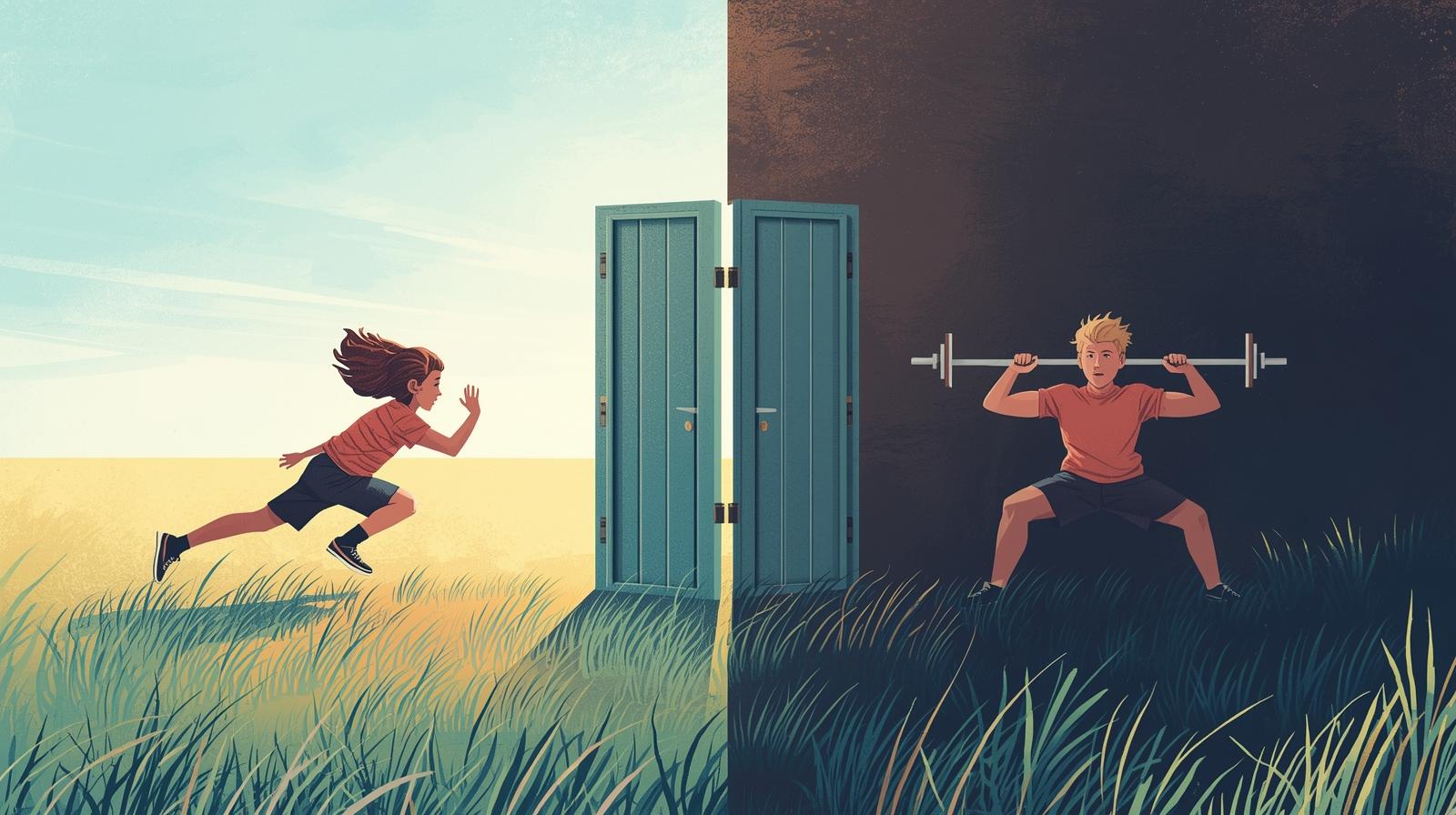Why Your 13-Year-Old Isn't Ready for the Training You Think They Need
Sep 16, 2025

The science behind long-term tennis development reveals uncomfortable truths about youth sports
Over 35 years of developing elite junior tennis players, I've watched parents make the same costly mistake repeatedly. They see other 13-year-olds lifting weights and immediately assume their child needs strength training to keep up. What they don't realize is they might be destroying their child's speed potential forever.
Here's what most tennis parents don't understand: your child's calendar age means almost nothing when it comes to training decisions.
The Development Window That Closes Forever
Throughout my coaching career, I've seen countless examples of players who seemed to lose speed and agility after their growth spurts—not because they became less athletic, but because their programs missed critical development windows. When a young player goes through rapid physical growth while focusing solely on technique lessons, they often miss the speed and agility work that research suggests should happen before puberty hits.
While not every athlete is affected equally, research indicates this window may not reopen. Studies suggest that missing this timing can significantly limit later gains in speed and agility. Some recovery is possible, but rarely to the same performance ceiling that would have been achievable with proper timing.
The research from Long-Term Athlete Development shows us that ages 11-14 span three completely different developmental stages. Research by Philippaerts et al. (2006) demonstrates that physical performance attributes like speed, agility, and explosive strength show peak development at different times relative to each individual's growth spurt. A 13-year-old girl who's finished growing needs aerobic training and strength work. A 13-year-old boy who hasn't started his growth spurt needs speed, agility, and technical skill development. Same age. Completely different training requirements.
Training Focus by Developmental Stage:
| Stage | Timing | Primary Focus | Why This Matters |
|---|---|---|---|
| Pre-Growth Spurt | Girls 8-11, Boys 9-12 | Speed, agility, skill acquisition | Neural pathways most adaptable |
| During Growth Spurt | Individual timing varies | Maintain skills, prevent injury | Rapid physical changes affect coordination |
| Post-Growth Spurt | Girls 12-14, Boys 13-15 | Strength, aerobic capacity, competition psychology | Hormonal changes optimize strength gains |
Yet most programs treat them identically.
The Foundation Principle Everyone Ignores
At Midcourt Tennis Academy—my program that operated in Charlotte and later at major public centers in Dallas—our fastest-developing players shared one characteristic: they came from diverse athletic backgrounds. The kid who played basketball in the off-season developed lateral movement and court awareness faster than the tennis-only specialist. The swimmer brought core strength and endurance that translated directly to match toughness.
Thai Kwiatkowski, who went on to win the NCAA Men's Singles Title at the University of Virginia, would leave our practice some nights at 11 years old and head to a baseball game. His dad wanted him to continue playing baseball until he hit a home run over the fence—not an inside-the-park version.
This isn't coincidence—it's biology.
My own learning curve taught me this lesson. About 15 years ago, when I took over Samuell Grand Tennis Center in Dallas, I realized something important: while I had successfully developed players like ReeRee Li from hitting her first ball to winning a Gold Ball, I had done so during an era before Red-Orange-Green ball progression existed. Now, with my two younger daughters starting to play, I needed to build a program that could systematically develop large numbers of young players.
ReeRee, less than a month older than Thai, went on to captain her team at Yale—another example of how proper development timing and multi-sport foundations create long-term success.
I've learned to recognize what I don't know—and when I do, I dig into the research. I became aware there was research on Long Term Athletic Development and went searching to become better informed. What I discovered validated many intuitive approaches I'd been using while revealing critical gaps in my systematic understanding.
I'm currently learning about neural networks as part of my work with artificial intelligence—the same commitment to staying informed about tools that can improve player development.
Think of athletic development like building a house. Tennis-specific training is the beautiful architecture on top. But you want the widest, strongest foundation possible underneath. Most parents start building the beautiful parts before the foundation can support the weight.
The concepts popularized by authors like Daniel Coyle in The Talent Code and Geoff Colvin in Talent is Overrated get misunderstood here. Parents think this means starting intensive tennis training as early as possible. But those 10 years of focused development begin after basic athletic literacy is established—typically around ages 8-10, not earlier. Starting intensive tennis training at age 6 doesn't give you a four-year head start.
It creates problems you'll spend years trying to fix.
When Programs May Not Align with Developmental Science
I can identify a program that may not fully align with developmental research within minutes of watching their players. Here's what concerns me:
They focus on strength training for 10-12 year olds when speed and agility development windows are wide open. They may miss the pre-growth spurt speed development that research suggests has limited recovery potential. They treat all kids the same regardless of individual biological development stage.
But why do some parents see success with early specialization? Occasionally, early-maturing athletes or exceptional cases like elite professionals appear to validate intensive early training. However, research suggests these visible successes may mask broader patterns of burnout and injury that affect most young athletes. The survivors we celebrate often succeeded despite early specialization, not because of it.
The signs become apparent once you understand developmental science. Kids who started early specialization often plateau around 14-15. They've missed optimal development windows and now face greater challenges against athletes who built broader foundations.
Countries that implement systematic, science-based development approaches have shown measurable improvements in elite athlete production. While comprehensive data across all sports remains limited, Tennis Australia's implementation of systematic player development principles correlates with increased success at junior international levels. The pattern suggests that systematic attention to developmental timing, rather than early specialization, may optimize long-term outcomes.
The Individual Assessment Reality
Rather than criticizing what other programs do wrong, let me share what we look for when assessing each student's development stage.
Physical development indicators: Has your child begun their growth spurt? This single factor changes everything about training priorities. Are they developing coordination naturally, or do they seem clumsy during rapid growth? How do they respond to different types of physical challenges?
Character development signals: Do they take ownership of their improvement, or need constant external motivation? How do they handle setbacks and losses? Are they developing work ethic to do difficult things even when they don't feel like it?
Every child follows a unique timeline. Some are ready for competition focus at 12. Others need more fundamental development. Some mature early and need different training than late developers. Our job is meeting each student where they actually are, not where we think they should be.
The Questions That Matter
Instead of demanding specific training approaches from coaches, ask questions that reveal whether your child's development is on track:
About individual assessment: Does the coaching staff understand where your child is developmentally? Are training priorities appropriate for their growth stage? How does the program adjust when your child goes through rapid physical changes?
About long-term planning: Is there a clear pathway extending beyond next month's tournament? Does the program include recovery and development periods? How are character and life skills being developed alongside tennis skills?
About your family's role: What can you do at home to support proper development? How can you balance tennis with other important parts of childhood? What does your child actually enjoy about tennis, and how can we build on that?
The Investment Reality Check
Elite development requires 10 years after age 8-10, not before. Money spent on inappropriate early specialization often gets spent again later fixing the problems it created.
Better approach: Right training at the right developmental stage.
Worse approach: More hours of wrong training at the wrong time.
The Long View
Tennis serves as a vehicle for developing successful human beings. Whether your child plays professionally, earns a college scholarship, or uses tennis as preparation for other pursuits, proper development principles serve them well.
The habits of effort, persistence, and continuous improvement transfer to any field they choose.
But only if we respect the biological timeline that governs when different types of development can actually occur.
Development happens in stages that can't be rushed. Physical, technical, and character growth all have optimal timing. Sometimes the best thing we can do is give young athletes time and space to develop naturally while providing appropriate support at the right moments.
When we get that timing right, we see remarkable growth—not just in tennis, but in the character traits that determine success in any endeavor.
References:
Balyi, I., & Hamilton, A. (2004). Long-Term Athlete Development: Trainability in Childhood and Adolescence. Victoria, BC: National Coaching Institute British Columbia.
Philippaerts, R. M., Vaeyens, R., Janssens, M., Van Renterghem, B., Matthys, D., Craen, R., ... & Malina, R. M. (2006). The relationship between peak height velocity and physical performance in youth soccer players. Journal of Sports Sciences, 24(3), 221-230.
Duey Evans has spent 35+ years developing elite junior tennis players and now consults with families navigating competitive tennis development. His systematic approach focuses on optimizing developmental windows rather than chasing short-term results.
Never Miss a Moment
Join the mailing list to ensure you stay up to date on all things real.
I hate SPAM too. I'll never sell your information.
